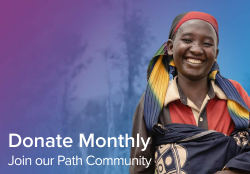Posts Tagged ‘World Relief DRC’
World Relief DR Congo is Building Resilience from Ashes
The Eruption
On May 22nd in the town of Goma, DR Congo, Mount Nyiragongo lit up the sky with a red glow. Many of the 2 million residents recognized the signs and feared the worst — the towering volcano was once again active. By early evening, their fears were confirmed when the volcano began to spew lava.
With orders to evacuate, many residents gathered what belongings they could and fled toward neighboring Rwanda and other areas in DR Congo. While the lava flow stopped short of reaching Goma, it destroyed the homes and livelihoods of thousands of people in the surrounding area.
Our own World Relief Congo staff were among those temporarily displaced from their homes and workplaces. And yet, they continued to care for local communities.
Following the eruption, World Relief dispatched a field team to assess the scale of the disaster. Along with partner agencies, they found that close to 95,000 people in 20 villages have been directly impacted by the eruption including the complete destruction of 3,873 homes, 13 schools, seven churches and three health centers. More than 20,000 residents were displaced and over 30 people died.
A Neglected Crisis
For DR Congo, the recent eruption of Mount Nyiragongo is the latest in a decades-long struggle for stability. The nation faces ongoing conflict between multiple armed groups. Sexual and gender-based violence and trauma are commonplace. Frequent attacks on villages disrupt people’s ability to feed and provide for their families.
Food insecurity has been identified as a neglected humanitarian crisis in DR Congo. Natural disasters like earthquakes and volcanic eruptions put even greater strain on limited resources. The eruption of Mount Nyiragongo is expected to have long-lasting effects on health, livelihoods and stability in Eastern DR Congo. Farmland, which people in nearby villages rely on to feed their families, has become unusable, covered by hardened lava rock. World Relief is collaborating with local communities and aid agencies to respond to this disaster and find solutions for these ongoing crises.
A Vision for Change
World Relief has a strong legacy of this kind of collaborative work in the region. For almost 20 years, we have partnered with local churches and communities to facilitate healing and stability in DR Congo.
World Relief Congo staff member, Berger Bireo, shared, “It’s easy to be overwhelmed and discouraged by [DR Congo’s] conflict-ridden history. There are days when I myself struggle to see beyond these seemingly devastating challenges. Yet, I believe that God gave us the very instrument needed to establish peace in DRC: the Church.”
At World Relief, we believe that when the church is mobilized to achieve its full potential, it has the power to change our world. And we’ve seen it happening in DR Congo.
Churches and believers in DR Congo are uniting around their shared identity in Christ to care for the vulnerable in their communities. Last year, World Relief partnered with local churches to provide 400 farmers with training on improved agricultural techniques, assist 450 women with post-Sexual and Gender-based violence care and provide access for 375,535 people to community-based conflict resolution mechanisms through our village peace committees.
In partnership with the local Church, we are addressing holistic factors that can not only increase stability in communities entrenched in conflict, but also bring physical, emotional and spiritual healing to the nation. This work is bringing real, lasting change that will help DR Congo become more resilient in the face of natural disasters like the recent volcanic eruption.
Not Forgotten
Although DR Congo is home to one of today’s most neglected crises, God has not forgotten the people in the “Heart of Africa.” And, in the face of natural and man-made disasters, neither has World Relief.
Amanda Patterson, HDRU Program Office for DR Congo and South Sudan, shared, “We know that this event is just one more challenge that the Congolese people must overcome. The silver lining is that the global spotlight will once again shine on DR Congo. It is a country that gets so little attention, and yet in sheer numbers alone, DR Congo is the number one country facing the largest global hunger crisis.”
As Goma and the surrounding region recover from the eruption of Mount Nyiragongo, we remain committed to improving long-term peace and stability in DR Congo. We will continue working alongside local churches to help them realize their own resources and power, through the Spirit, to transform lives.
Source: https://www.wfp.org/countries/democratic-republic-congo
You and your church can join us in empowering local churches and creating lasting change in places like DR Congo by joining The Path.

Kelly Hill serves as a Content Writer at World Relief. She previously served as Volunteer Services Manager at World Relief Triad in North Carolina before moving to Salt Lake City. With a background in International and Intercultural Communication, she is passionate about the power of story to connect people of diverse experiences.
The DR Congo in May – “We pray and carry on”
Jesse Thornburg, World Relief Volunteer in the DRC, tells the story of DRC’s most recent uprising:
For eastern DR Congo, this has been a scary and puzzling week. The new leader of the M23 rebels, Sultani Makenga, has for the past month been openly threatening via radio to attack the city of Goma, but no action resulted for weeks on end.

More stressful than “the boy who cries wolf” is the pack of wolves who cry “we will eat you” but stand peacefully by (armed and ready) for weeks on end. Then suddenly, the M23 rebels fulfilled their threats and attacked Goma last Wednesday morning.
They fought with the government and UN troops in the western parts of the city while we listened on the eastern edge. From our office, we heard the gunshots and artillery explosions falling – just like in November, but this time the explosions were much closer and within the city limits, around some of our staff members’ homes and an orphan center we support.
As our staff were being sent home, I hastily packed a few bags and drove our 3 American visitors into Rwanda. The visitors took it surprisingly well, especially considering two were new to Africa. The situation had accelerated so fast – that morning I spent the first hour of the workday as usual, thinking it would be just another day.
The fighting continued until the evening, and suddenly it stopped. It appeared the rebels had attacked in anticipation of UN Secretary General Ban Ki-moon’s visit to Goma the next day. But in a bizarre turn, by the next morning (Thursday, 5/23) both sides had agreed on a ceasefire (see http://www.bbc.co.uk/news/world-africa-22634535). The UN troops stopped shelling, cleaned their tanks and trucks, then came out in clean uniforms to welcome their esteemed visitor. Mr. Ki-moon came and went as planned. The rebels withdrew outside the city and have remained peacefully there ever since.
I returned to Goma yesterday morning. We pray, listen, and wait, but so far the coast is clear. We don’t know if the rebels were making some sort of one-day statement or if they were pressured to leave by the DRC government, but we hope a viable, lasting peace is being formulated now.
In the end, at least 19 people (including several children struck by artillery) were killed last Wednesday with little warning, with 7 days of peace starting the next morning.
My friendquoted a Swahili proverb that perfectly captures the situation: “When elephants fight, it’s the grass that suffers.” Here, as so often in Africa, “big men” play their games for power and wealth, but they usually face no repercussions. It is their citizens, the poor and helpless civilian families, who pay the price. Bwana atusaidie (The Lord help us).

Our fluctuating situation, from violence to tense anticipation to violence, seems to fit with Isaiah’s cries in Isaiah 59. The passage is long but when read together, it gives a picture of how many of us feel.
Tunaomba na tunaendelea (We pray and carry on),
Jesse
Photos by Christine Anderson


